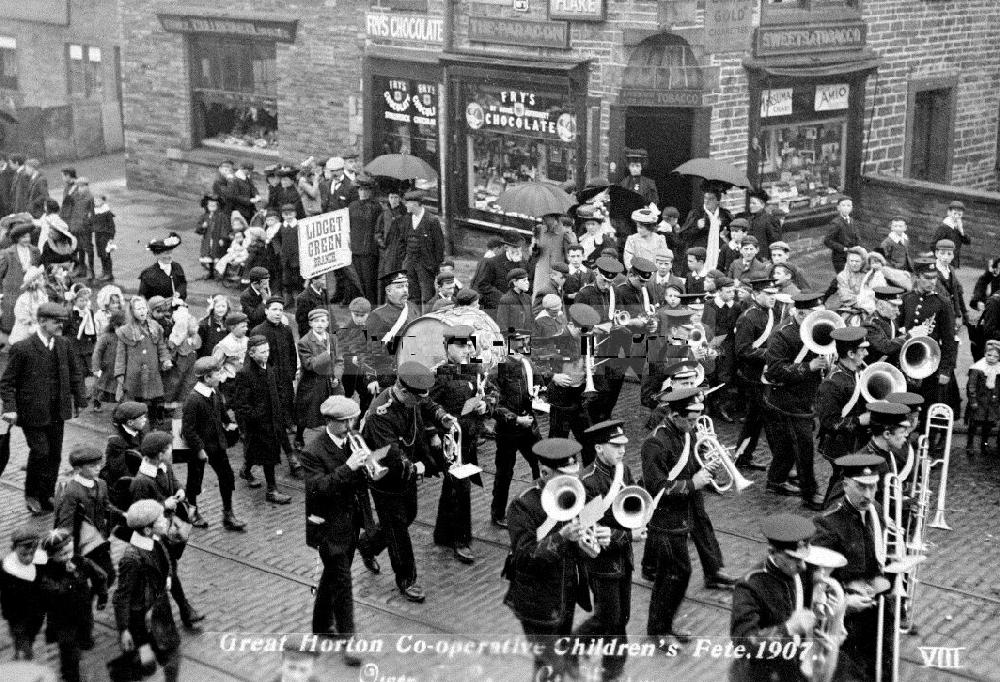
English Economy: Coopeartive Movement

Figure 1.--The English cooperative movement began and was always the strongest among the working class in northern England. Here the Great Horton Co-operatibe havevorganized a children's event in 1907. Great Hiorton is a neighborhood in Bradford, an industrial city in Yorkshire (northern England). There were all kinds of diffeent coops. The most common were retail establisg
hments. The coops have gradually declined in the 20th century. A range of cultural and demofraphic changes haven adversrly affected the coops.
|
|
One alternative to capitalism that developed in the 19th century was the Co-operative or Co-op Movement. The Rochdale Pioneers' shop in northern England launched what would become the Co-op Movement (1844). It was part of the Victorian era of reform as the English grappeled with the social problems resulting from the Industrial Revolution and Capitalism. The Co-op Movement was seen as an alternative to the corporation. A wide range of co-ops were organized, including credit unions, energy, football supporters, funeral care, health care, hosing, manufacturing, retail, schools, and various worker-owned businesses. This effort went far betond the cooperative movement in America which was primarily limited to agriculture, cedit unions, and rural electic coops. The British Co-operative Movement is most commonly associated with The Co-operative brand, best known for its supermarketd. There are, however, thousands of registered co-operative businesses. The Coooerative movement was of sime ijmportance at the turn of the 20th century (figure 1). The movement has declined in recent years. Co-ops now generate some £35 billion, onlky about 1 percent of the country's GDP. Most active cooperatives belong to Co-operatives UK -- the central membership organisation. for co-operative enterprise throughout the UK. This is a co-operative of co-operatives: a co-operative federation. Most kinds of co-operatives are eligible to join Co-operatives UK. A range of develooments have led to the decline of the movement, including e-industrialisation, association with the working poor, edevelopment of terraced housing which had many Co-op stores, featured co-op stores dotted throughout) to newer purpose-built estates, with around 18,000 co-op stores. Inflation and a strong pound during the 1970s which led cheap imported goods – devastating many manufacturing businesses. The retail sector transitioned toward large supermarkets and hypermarkets. Another major isue is that the Enbglisg working class had changed. Muxh of the working class is now has essentially moddle-vlas life styles. Not only are they not just attracted by low prices, but the coop stores no longer offer aooreiably better prices. The British working class nowvhas essentially the same desire for fashion as the middle-class. A serious problem throughout the history of coopeartives has been the lack of maagerial talent, especially with the retail operations. The stoes were often not price competitive or offered trendy fashions.
CIH

Navigate Children in History Website:
[Return to the Main English economy page]
[Return to the Main English page]
[Return to the Main European economics page]
[Introduction]
[Animals]
[Biographies]
[Chronology]
[Climatology]
[Clothing]
[Disease and Health]
[Economics]
[Ethnicity]
[Geography]
[History]
[Human Nature]
[Law]
[Nationalism]
[Presidents]
[Religion]
[Royalty]
[Science]
[Social Class]
[Bibliographies]
[Contributions]
[FAQs]
[Glossaries]
[Images]
[Links]
[Registration]
[Tools]
[Children in History Home]
Created: 10:04 PM 10/20/2019
Last updated: 10:04 PM 10/20/2019



